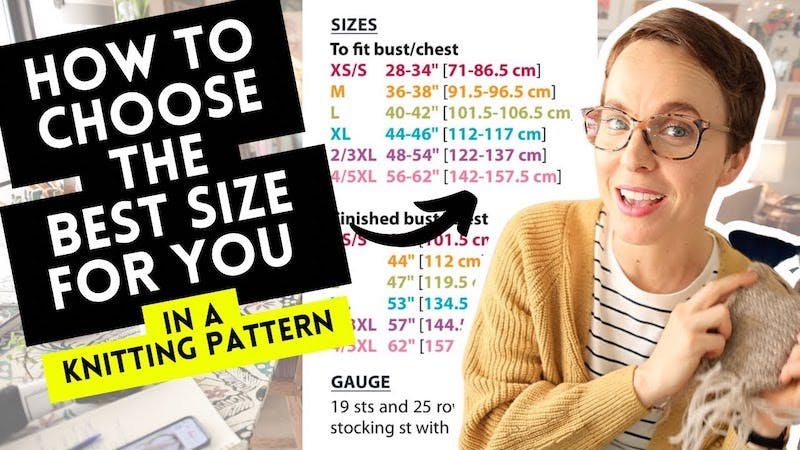
Let it fit! 2 tips for choosing the best size for you.
Share
I'm excited to share some good news! My next pattern release will include a wider range of sizes, from 3XS (bust/chest 69 cm/27 inches) to 6XL (bust/chest 136 cm/53.5 inches). I wanted to make sure there's an option for everyone!
While adding more sizes might seem like simple math - just increasing stitches and rows - it’s actually quite complex, especially when it comes to plus sizes.
It's inspired me to put together a few helpful tips to guide you in choosing the perfect size for any top garment.
Let's use Andrea Mowry's popular "Stripes" sweater (featured pattern of this week) as an example and meet our knitting hero, Ann.
Tip 1. Start with your measurements.
Ready-to-wear clothing sizes often don't match knitting patterns, and many patterns use numerical sizes instead of standard S, M, L labels.
1. For the best fit, start by measuring your full bust circumference.
Ann’s full bust circumference is 98 cm/38.5 inches.
2. Next, check the pattern’s recommended ease. This is the difference between your body and the finished garment. Positive ease means the sweater is larger than your body. Negative ease means it’s smaller.
Ann: The “Stripes” pattern suggests a positive ease of 2 to 6 inches/5-15 cm. Ann’s desired finished sweater measurement is 98 + 15 = 113 cm. Or 38.5 + 6 = 44.5 inches.
3. Now, let’s look at the pattern sizes:
Sizes: 1 (2, 3, 4)(5, 6, 7)(8, 9, 10).
Finished sweater circumference: 34.25 (37, 40, 46)(50.5, 55, 59.25)(63.75, 68, 72.5)” or 87 (94, 101.5, 116.5)(128, 139, 150.5)(162, 173, 184.5) cm
Ann: Based on the pattern, she can choose between sizes 3 and 4. Size 3 would be a fitted sweater, while size 4 would have a larger ease. Since the designer’s sample has 15 cm/ 6 inches of positive ease, Ann might prefer size 4 for a similar look.
Plus size tip: If you have a larger bust, consider measuring your upper bust instead of your full bust for a better fit. Or, measure the width of your favorite well-fitting garment at the underarm and double it to estimate your desired bust circumference.
This method works best if you have the gauge specified in the pattern. What if not?
Tip 2. Knit a swatch.
Knitting a swatch is essential to check your gauge. If your gauge is slightly off but you don’t want to change yarn or needles, here’s a helpful tip:
1. Count how many stitches you have in 10 cm/ 4 inches of your swatch = A.
Ann: 20 sts in the 10 cm/ 4 inches piece.
2. Divide 10 cm/4 inches by the stitch count to determine the width of one stitch.
Ann: 10/20 = 0.5 cm or 0,2 inches.
3. Go to the Body section in the pattern and check how many stitches are in the body for your size = B.
Ann: Would like to knit size 4 and her size has 248 stitches for the Body.
4. Multiply the stitch count for your desired size by the stitch width to calculate the finished sweater circumference. A x B = C.
Ann: 0.5 cm x 248 stitches = 124 cm or 0.2 inches x 248 stitches = 49 inches.
5. Check the positive ease you will get with your yarn.
Ann: final sweater is 124 cm/ 49 inches minus bust 98 cm/ 38.5 inches = positive ease 26 cm/ 10.5 cm. It is way larger than the recommended ease. So Ann should go with a size smaller, if she wants to stay with her yarn or needle size.

If you would like to understand this method better, check the video from Wool Needles Hands who will explain it in detail.
I hope these tips help you achieve the perfect fit for your next knitting project! I’d love to hear from you! Have you struggled with finding the right size? Feel free to reply and share fitting challenges or triumphs!
📔 Pattern of the Week: “Stripes!” by Andrea Mowry.

Why you'll love it:
- Beginner-friendly: A classic top-down round yoke sweater worked in simple stockinette stitch.
- Stash-busting: The color stripe option lets you use up all those leftover yarn scraps. Or, keep it simple with a single color for a classic look.
- Detailed instructions: The pattern includes helpful notes and supporting videos for any tricky techniques.
- Collar options: Choose between a wider, more relaxed collar or a closer fitting, more structured one.
My take: I adore everything about this sweater, but it's worth mentioning that it's worked with sport weight yarn (quite thin) and the main fabric is knit with US 5/3.75 mm needles. This means it can be a bit time-consuming.
If you're new to sweater knitting, I recommend starting with an aran or even bulky yarn to see quicker results and stay motivated.
🧶 Featured yarn of the week: Recollect Sport by The Farmer's Daughter Fibers. Andrea Mowry used this yarn for her sample sweater.

- This luxurious yarn is a blend of 75% White and 25% Black Non-Superwash MT & WY Rambouillet.
- It comes in a 57-gram (2-ounce) skein with approximately 185 yards (169 meters) and is categorized as a sport weight yarn.
- The recommended knitting gauge is 24 stitches per 4 inches (10 cm).
While this yarn is undeniably luxurious, it comes with a hefty price tag of $28 USD. But did you know that Rambouillet wool has a fascinating history? It's a tale of royal ambitions, daring escapes, and a revolution that shaped the textile world. You can read the full story here.
Luckily, Andrea has also shared some yarn substitution ideas to help you find a more budget-friendly option. This guide can also be helpful for similar weight yarn projects.
❤️ I hope this Esenote was useful and inspiring.
Warm regards,
Julia Piro
Knitwear Designer & Esenotes Curator
